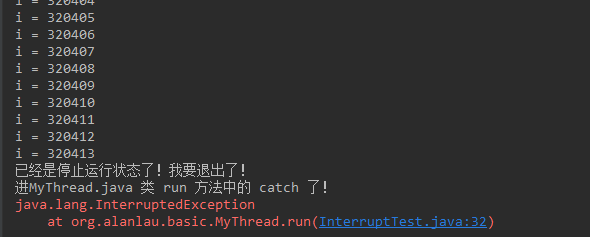Java多线程-停止线程
1、Java中终止正在运行线程的3中方法:
1)run()方法完成后,正常终止
2)使用 Thread.stop()强行终止
3)使用 Thread.interrupt() 中断线程
2、Thread.stop()
这个方法发可以停止一个线程,但是最好不用它,因为这个方法是不安全的,而且已经被弃用(被注解为 @Deprecated)
stop()方法的缺陷:
1)强制让线程停止,可能使一些清理性的工作得不到完成。
2)对锁定的对象进行了“解锁”,导致数据得不到同步的处理,出现数据不一致的问题。
3、Thread.interrupt()
直接调用不会终止正在运行的线程,需要加入一个判断才可以完成线程的停止。
Thread.interrupt() 只是改变了当前线程的 interrupt 状态,并不是真的停止了当前线程的运行
获取线程的 interrupt 状态有两个方法:
1)interrupted() 静态方法
2)isInterrupted() 非静态方法
区别:
interrupted():获取当前线程的中断状态,执行后具有将状态标志清除为 false 的功能,所以连续两次调用 interrupted 第二次会输出 false
isInterrupted(): 获取线程对象的中断状态,执行后,不清除中断状态
4、Thread.interrupt() 配合“异常法”停止线程
主要思想就是,获取到线程的中断状态为 true 之后,就抛出异常,结束线程代码块的执行
public class InterruptTest { public static void main(String[] args) { try { Thread thread = new MyThread(); thread.start(); Thread.sleep(2000); thread.interrupt(); } catch (InterruptedException e) { System.out.println("main catch"); e.printStackTrace(); } } } class MyThread extends Thread { @Override public void run() { super.run(); try { for (int i = 0; i < 500000; i++) { if (this.isInterrupted()) { System.out.println("已经是停止运行状态了!我要退出了!"); throw new InterruptedException(); } System.out.println("i = " + (i + 1)); } } catch (InterruptedException e) { System.out.println("进MyThread.java 类 run 方法中的 catch 了!"); e.printStackTrace(); } } }
执行结果如下:


